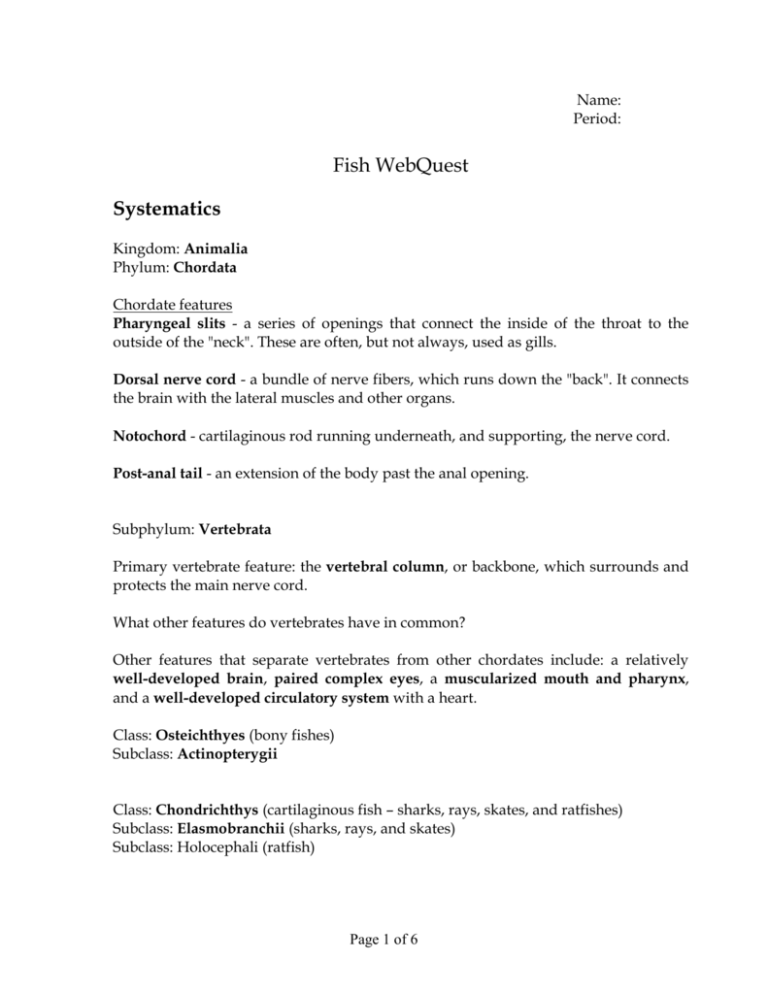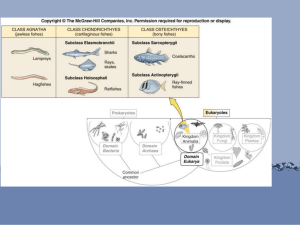Chordate features
advertisement

Name: Period: Fish WebQuest Systematics Kingdom: Animalia Phylum: Chordata Chordate features Pharyngeal slits - a series of openings that connect the inside of the throat to the outside of the "neck". These are often, but not always, used as gills. Dorsal nerve cord - a bundle of nerve fibers, which runs down the "back". It connects the brain with the lateral muscles and other organs. Notochord - cartilaginous rod running underneath, and supporting, the nerve cord. Post-anal tail - an extension of the body past the anal opening. Subphylum: Vertebrata Primary vertebrate feature: the vertebral column, or backbone, which surrounds and protects the main nerve cord. What other features do vertebrates have in common? Other features that separate vertebrates from other chordates include: a relatively well-developed brain, paired complex eyes, a muscularized mouth and pharynx, and a well-developed circulatory system with a heart. Class: Osteichthyes (bony fishes) Subclass: Actinopterygii Class: Chondrichthys (cartilaginous fish – sharks, rays, skates, and ratfishes) Subclass: Elasmobranchii (sharks, rays, and skates) Subclass: Holocephali (ratfish) Page 1 of 6 Florida Museum of Natural History 1. What two types of fish belong in the Superclass Agnatha? 2. What two structures do they lack? 3. Sharks (Class Chondrichthyes) have an unlimited supply of what? 4. How can you tell the sex of a member of the Chondrichthyes? What is the function of this structure? 5. How do the Osteichthyes differ from the Agnatha and Chondrichthyes? Morphology University of California Museum of Paleontology 6. Describe the jaws of teleost fishes. 7. What is an operculum? 8. Which class of fish generally lacks an operculum? Page 2 of 6 Page 3 of 6 Check out the Digital Fish Library for a close-up of gills. 9. What type of fish has external gills when young? Australian Museum Fish Site 10. Do all fishes have scales? Explain. 11. What is the primary function of scales? 12. What are the four main types of scales? Sketch scales of each type. 13. What type of scales do sharks have? Do they increase in size as the shark grows? What gives the shark its rough texture? Page 4 of 6 14. How can you determine the age of a fish? Digital Fish Library at UCSD Select the view of the shark. Use the mouse to scroll over body parts. 15. What is the function of the pectoral fin? 16. What is the function of the pelvic fins? 17. What is the function of the first dorsal fin? 18. What is the function of the caudal fin? 19. What is the function of the lateral line? 20. What is a nictating membrane? Adaptations Florida Museum of Natural History 21. What are four adaptations found in fishes? Page 5 of 6 22. What is the name of the system that elasmobranches use to locate prey by detecting electromagnetic fields? Where is it located? Fish Schooling Rhode Island Sea Grant 23. During some phase in their life cycle, schooling occurs in what percent of fish species? 24. What are some advantages for fish that school? 25. What system on some fish aids in schooling? How does it do this? 26. If fish do not have this system (see 25), what organ do they use to form schools? Write down 5 interesting things that you learned from one of these web sites. They can’t be answers to any of the above questions. Page 6 of 6











